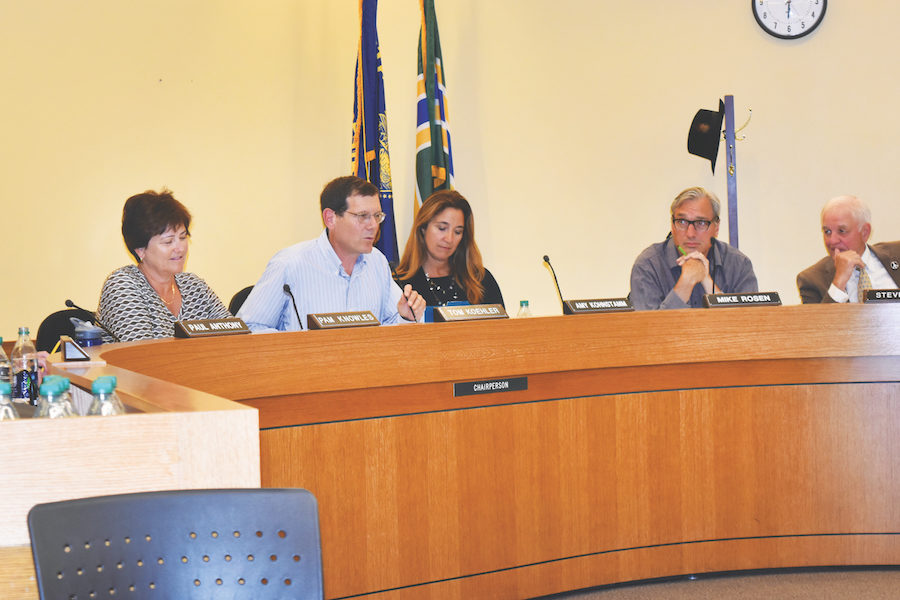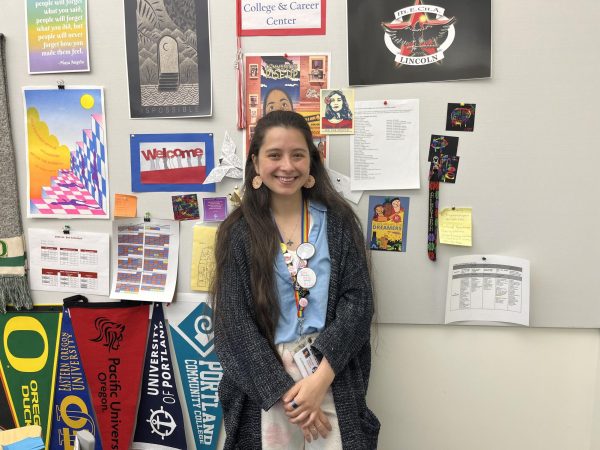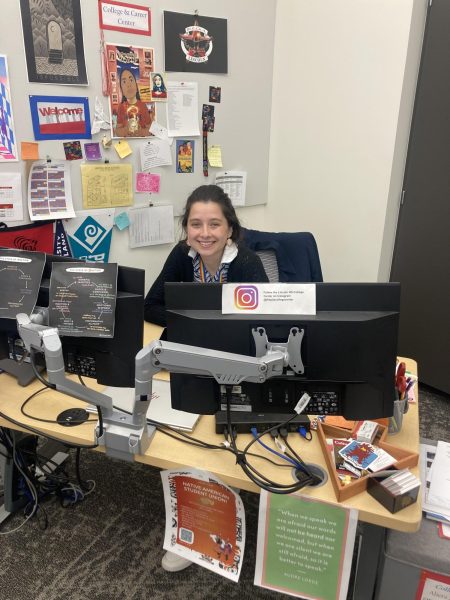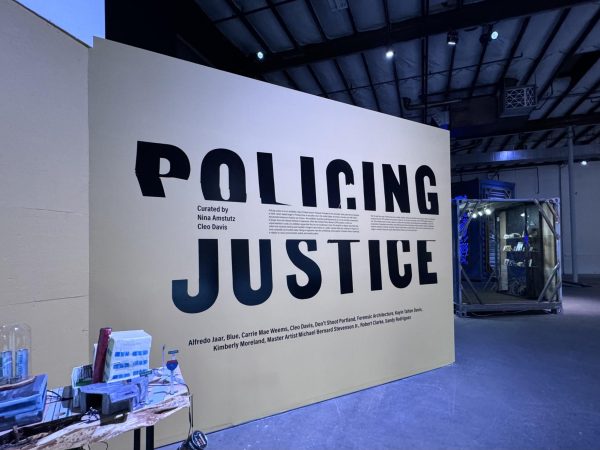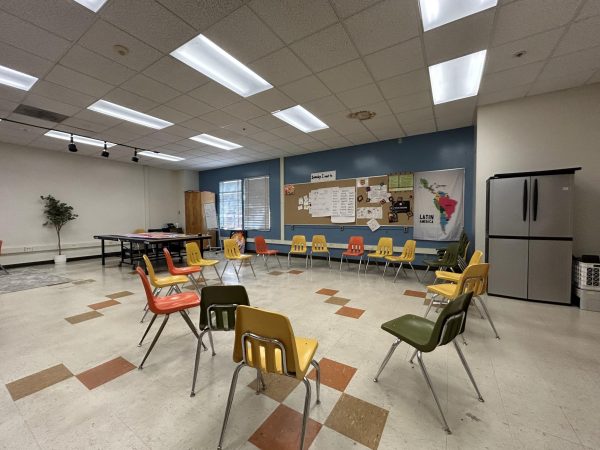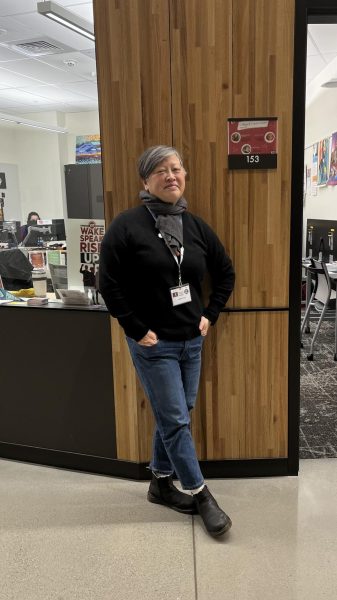Portland voters will decide on Lincoln rebuild this May (updated)
The PPS school board (above) will voted Tuesday to place a school modernization measure that includes Lincoln on the ballot this May.
Updated: Tuesday 7:30 p.m with the official board vote.
The Portland Public Schools Board voted unanimously Tuesday to place a $790 million bond package on the ballot May 16. If passed, the measure would pay to rebuild Lincoln High and Kellogg Middle School, renovate Benson and Madison high schools and fund $150 million in health and safety improvements across the district.
Students have already spent the last few weeks gearing up for what may be a tough campaign. An estimated 80 percent of the May electorate are not parents, and must be convinced to overcome distrust of the district and stomach the largest bond measure in state history. The support of every student will be helpful in the campaign, its leaders say.
One of those advocates is sophomore Raja Moreno. Moreno is also in the process of officially forming a political action committee (PAC) to support the measure. Its name is Students Helping Organize Votes to Enhance Learning Spaces (SHOVELS).
Though many Americans dislike PACs, seeing them as organizations that “buy elections,” Moreno said it will help give the campaign legitimacy, especially to overcome the concerns some might have about an effort run by teenagers.
Moreno has a core group of 15 former Constitution Team members working with him to form the organization, and they will soon have a website where parents and students can sign up to volunteer or donate.
Most of the campaign efforts will be things anyone can do, he said. “We’re planning on running a social media campaign, raising funds for advertising, and distributing campaign materials.” His PAC already created social media pages and will be printing flyers. It will also train volunteers in campaign messaging before they go out to canvass neighborhoods.
Also working the campaign are seniors Tyler Honn and Michael Ioffe, the latter of whom led the student walkout in September over the delay of this bond. Ioffe and Honn plan to mount a video of student perspectives on why the bond is needed, and will try to engage with traditional news media to spread the same message.
“Hopefully we can get some free air time,” Honn said.
Like Moreno, Honn emphasized the importance of spreading the word on social media, as well as engaging with the prominent business and community leaders in the Lincoln community, who can help appeal to a wider audience.
“Every single vote will count,” Ioffe said at a meeting of student organizers Feb. 9.
Also in attendance at that meeting were students from Grant, Cleveland, and Wilson high schools and Metropolitan Learning Center.
“It’s super important to engage other schools because [the bond] affects all of us, but also in terms of political perception,” Moreno said. “It’s important that this is seen as a diverse inclusive team – not just an effort by students who can afford to spend time and resources on it.”
***
Amy Ruiz, who conducts polls for PPS, said that initial numbers looked good.
“Before even hearing any information, nearly 60 percent [of those polled] support a $750 million measure, which is a strong showing, as you want to be right around the 60 percent mark,” she said at a Feb. 8 Town Hall meeting about the bond. Forty percent of those asked “strongly supported” the measure, another strong sign, she said.
But “we have to make sure people follow through on that response to the poll,” Moreno said.
Even getting those voters to fill out their ballots will be difficult. Since they typically lack the contentiousness of the November elections, turnout for May elections is typically around 35 percent. And with 80 percent of those voters being non-parents, advocates must not “[preach] to the choir” of PPS, said Eleni Kehagiaras, chair of the Long Term Development Committee.
Certain messages will be key for voters to hear, she said.
Emphasizing the health and safety improvements, and informing voters that the 2012 bond measure they passed is on time and on budget, will help gain support, organizers said at the Town Hall, especially since trust in the district brittled after revelations of lead in water pipes last summer.
Kehagiaras said another important aspect of the project that needs to be included in messaging is that “We’re not just building shiny new high schools; we’re improving graduation rates.” Other aspects that appeal to non-parent voters are improving equity and ensuring safe spaces for children.
The support of corporate leaders will be key, and the way to gain it is telling businesses that the bond will improve quality of life for the whole community, not just for students.
“The community uses the track and the building, and it could be used in emergency. This needs to be spread,” Kehagiaras said. Further, business leaders want Portland to be a thriving city, and a key part of that is strong schools, Lincoln principal Peyton Chapman said.
Students could have one very important ally in their advocacy: new Portland mayor Ted Wheeler, who told students at a Town Hall session at Lincoln last year he would support a school bond.
The Cardinal Times reached out to Wheeler’s office, and spokesman Michael Cox said the mayor “remains supportive of a bond,” but would have to “review the final version before officially endorsing it.”
***
With the extra time afforded by the delay of the bond to May, PPS staff and community members from the three high schools worked to refine the contents of the bond package.
One of the questions was whether to restore or completely rebuild Lincoln. Planners determined it would cost $60 million more to renovate than start over, because it requires the erection of a $30 million temporary facility on the field during construction and $20 million for deepening the foundation, said Eric Hurding, Capital Project Director, Lincoln project, at the Long Term Development Committee meeting Jan. 30.
However, Benson and Madison will be restored, as Benson is a historic landmark and both are currently under capacity, according to Hurding. Benson is already 200,000 square feet larger than Lincoln. For those schools, modernization is not about space, but the quality of that space.
While the high schools were a sure choice to be included in this year’s bond, Kellogg Middle School was more contentious. The Southeast Portland school has been closed for 10 years, but proponents say it is essential to balance enrollment in the area. The Board agreed, and raised the package by $45 million to fund it.
Some have questioned why the district is still rebuilding schools and only setting aside $150 million for health and safety improvements when the current estimate for deferred maintenance across the district is $1.65 billion, and the revelations last summer showed that maintenance issues are putting children’s safety at risk. Officials said the $150 million figure was simply due to the logistics of the project and the availability of contractors.
“There’s only so much work you can do given the restricted time periods” of summer break, interim PPS Chief Operating Officer Courtney Wilton said at the Town Hall. This $150 million will fund six or seven summers of work, then more money will come from a future bond, Hurding told the LTDC.
In a series of Town Hall meetings over the past few weeks, community members discussed which safety improvements to prioritize, and came up with a list that was approved by the Board Tuesday. It includes fixing lead plumbing issues in all 90 of PPS’ buildings, improving fire safety in some schools, abetting asbestos in around half of schools, mitigating lead paint problems across the district, and more.
Of course, all of these plans would have to be scrapped if the measure failed.
“If the voters say no to the whole thing, we have zero for all these projects. It’s all or nothing,” Wilton said.
Further, if it fails in May, Chapman believes that it will be a long time before the district can come out with a new package. “In terms of fundraising, it’s hard to ask businesses to come up with thousands of dollars twice.”
***
If it does pass, however, things look good for Lincoln.
Chief of School Modernization Jerry Vincent said at the Town Hall that a two-year planning period for Lincoln would begin immediately after the bond passes, and would conclude in Spring 2019, roughly around when Grant High School’s remodel, which is already under way, finishes.
Plans call for the new school to be built where Lincoln’s athletic field currently sits, meaning students attending Lincoln at the time would not have to move out during construction. That means work could start right away when planning is completed, while Benson and Madison must wait until summer. With the project estimated to take three years, the new Lincoln would likely open in 2022. That timeline is subject to Board approval.
Lincoln would likely receive very little of the $150 million in health and safety funding, as it is to be rebuilt, even though students will remain in the building for at least five more years. This was a point of contention at the Feb. 8 Town Hall. Wilton told a community member, “Our attention is on the other buildings, but we’ll respond to any major safety issues [at Lincoln].”
Based on the proposed timeline, not even current freshmen who help with the campaign will see the fruits of their labors. But student leaders still say everyone still has a responsibility to help.
“If you like this community at all, then it’s our obligation to do it,” Honn said. “If you come back home and the area has deteriorated, a lot of that will be due to not taking action now.”
In addition, “teachers deserve a better place to teach.”
He evoked a lesson many students probably learned in the Kindergarten. “We should leave a place better than when we found it.”
Moreno agreed. “It is our duty as both responsible citizens and as students who are suffering years of a crumbling building to stand up and make a change on behalf of the next generation of Lincoln students.”
Sagarika Ramachandran contributed reporting.

